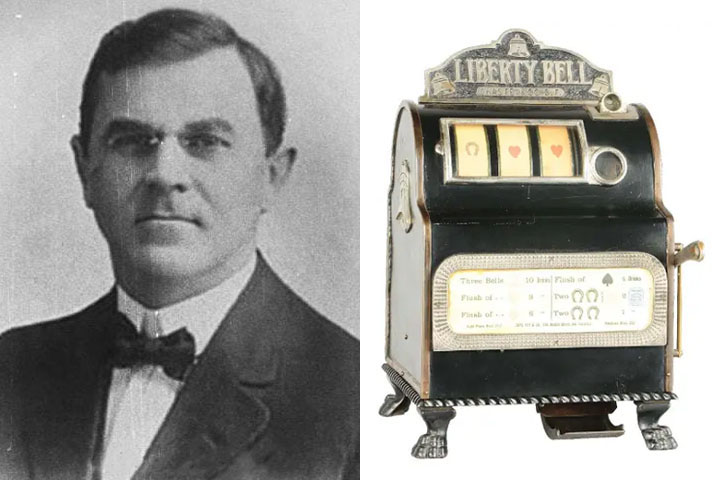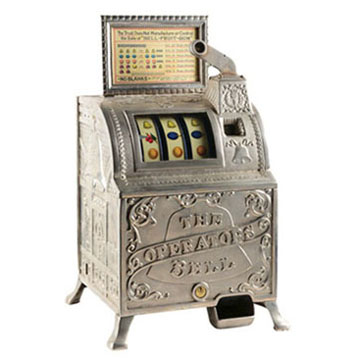Historically, Charles Fey is the man who invented slot machines in 1894. The title inventor of the world’s first slot machine goes to him because his invention featured an automatic coin payout system.
Charles Fey was from Germany, born on February 2, 1862 in Vöhringen, Bavaria. He was an instrument maker by trade, but at the age of 18 his desire for discovery led him to work in France, then in England. In 1885, in search of a new life, he joined his uncle in New Jersey, USA. After traveling through several US states, he finally settled in San Francisco.
He worked in various San Francisco factories before opening a machine maintenance and repair workshop in 1890, at the age of just 28.
In his spare time, he started working on the idea of making a slot machine. Between 1890 and 1894, and after several attempts, he managed to build the first mechanical slot machine with automatic payout. He decided to call it Liberty Bell.
His invention became famous in 1895! This recognition made Charles Fey the father of mechanical slot machines. Even today, modern slots are reminiscent of the original concept of Fey’s machines.

1894 Slot Machine
Charles Fey’s first gambling device, the Liberty Bell, worked by inserting a coin into the slot. Then, by pulling a lever, the machine’s reels began to spin, finally stopping with three symbols aligned. Winning combinations rewarded the luckiest players, with results being determined by chance. The reel mechanism was based on the principle of random number generators.

Charles Fey’s Slot Machine Business
By 1898, Fey had created a lucrative business model by making his Liberty Bell slot machines available in San Francisco saloons. He earned profit margins of 50% on the revenue from his machines.
When proprietors began having problems with players who cheated by inserting fake nickels, Fey altered the machine by adding a detecting pin, which was able to distinguish real coins from fakes. As a result, Fey’s machines were in high demand by establishments looking to reap juicy profits. In their heyday, Fey’s slots were installed as far away as the San José peninsula.
Slot Machine Industry
In 1900 Charles Fey decided to work exclusively on slot machines, thereby launching the slots industry in the United States. Had he lived through the early days of the Las Vegas casinos in the 1950s, he would undoubtedly have been one of the richest men in the USA.
The spread of Fey’s slot machines throughout San Francisco and the surrounding area attracted his competitors’ attention. As Charles Fey had not protected his inventions with patents, the machines were copied and commercialized. The Mills Novelty company, one of Fey’s competitors, manufactured slot machines that bore a striking resemblance to the Liberty Bell machines.
San Francisco Earthquake in 1906
On April 18, 1906, production of Fey’s slot machines came to a halt! On that day, a magnitude 7.9 earthquake destroyed San Francisco’s financial district, which was subsequently engulfed in flames. Many manufacturers moved their production sites east after the disaster, but Fey chose to remain in San Francisco. With the support of Mary Phelan, a prominent politician, Fey was soon back in business. After only four months, Charles Fey’s business was booming.
Prohibition
In 1909, San Francisco authorities banned slot machines. Many players had lost a lot of money on Fey’s machines, as well as on other manufacturers’ slots. In response to these gambling problems, legislation was passed banning slot machines throughout California.
The prohibition led manufacturers to change their slot machines. Instead of coins, the machines dispensed various prizes such as drinks, cigars and credit tokens to be used in the city’s bars. The prizes were handed out by the saloonkeepers.
Slot Machines and Chewing Gum
In 1909 the Industry Novelty Co., one of Charles Fey’s competitors, invented machines that dispensed chewing gum. These machines paid out chewing gum instead of cash, so they were in compliance with the law.
Industry Novelty machines had fruit symbols on the reels, suggestive of various chewing gum flavors. Winning bets gave players one or more sticks of chewing gum. It was a rather wacky idea, but it proved to be quite successful. Thanks to a mechanism, winning players automatically received their prizes.
Mills Novelty Company

To establish himself as a market leader, Herbert Mills of the Mills Novelty Company developed The Operators Bell slot machine in 1910. Copied from Fey’s Liberty Bell models and inspired by Industry Novelty chewing gum machines, this machine offered chances to win coins. One of Mills Novelty’s machines, the Liberty Bell GUMFRUIT manufactured from 1910 to 1915, is now a museum piece. |

Mills Novelty machines were elegant and attractive. A year after the launch of “The Operators Bell” games, the fruit symbols on the machines were replaced by BAR symbols. These symbols represented packets of chewing gum, not gold bars as many people still believe today. From 1910 to 1930, the Chicago-based Mills Novelty Company was one of the largest US manufacturers of prize-winning machines. Nowadays, the company specializes exclusively in the maintenance of violin machines. |
Invention of the Jackpot Machine
Charles Fey invented the JACKPOT machine in 1916. One of the game’s winning combinations paid out all of the machine’s coins. So Charles Fey was also behind the first jackpot slot machines.
Mafia and One-armed Bandits
In the United States, the history of slot machines is intertwined with organized crime! Like the alcohol, drug and construction industries, the slots industry was run by mafiosi in the 1920s and 1930s. Not only was the supply side dominated by a monopoly of the Mafia, but the machines were rigged too. All the major figures of mafia operations were involved – Lucky Luciano, Frank Costello and Vito Genovese. These organized groups operated slot machines in bars and underground clubs in Chicago and New York.
Of course, Charles Fey, like all slot-machine manufacturers at the time, had no direct links with the Mafia in the USA.
Charles Fey’s Personal Life
Born into a family with 15 siblings, Charles Fey never imagined he would become the inventor of the slot machine.
At the age of 23, he immigrated to the USA to live with his uncle in New Jersey. He had worked as an instrument maker from an early age, and had good professional skills. He set up his own company in San Francisco!
In 1880, Fey was diagnosed with tuberculosis. In accordance with scientific knowledge at the time, he moved to a warmer climate, in Mexico. A few years later, he returned to San Francisco for a series of creosote treatments, which were successful.
Charles Fey met his future wife, Marie Christine Volkmar (1866-1942) in San Francisco. He married Marie in 1889, and they had four children: three daughters and a son.
Around 1890, Charles August Fey changed his name, because he didn’t like his nickname Gus. From then on, his name was Charles Fey.
He died in San Francisco in 1944, aged 82. His son, Edmund, tried to take over his father’s business, but it failed to stand up to the competition.